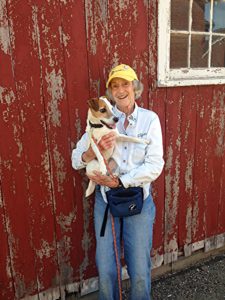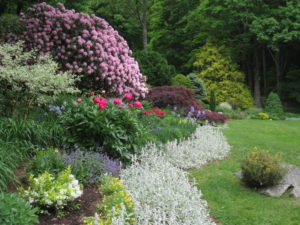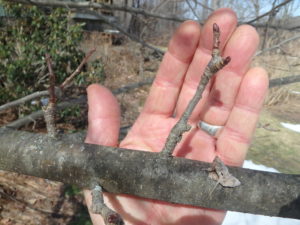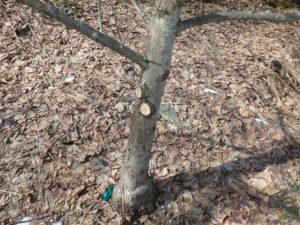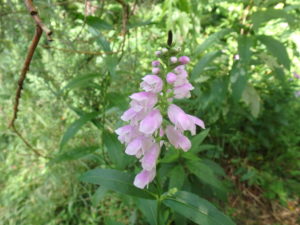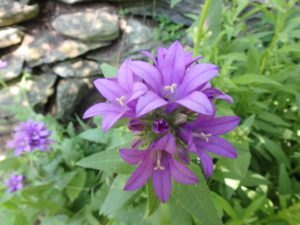Books by Sydney Eddison
Photos: K Day Designs
I’m a fairly simple person. I like dogs and flowers and good food. Having friends is important. I like to grow vegetables from seed, and I revere trees that have survived longer than I have. And when it comes to poetry, I like it simple and direct, poetry that evokes images of nature and emotions I can understand. So it was a great pleasure when my friend the garden writer Sydney Eddison sent me her new book of poetry, Fragments of Time: Poems of gratitude for everyday miracles (Pomperaug Valley Press, 2016).
Fragments of Time is a lovely book of poems, many that focus on Ms. Eddison’s gardens and her love for the outdoors. But a few are love poems about her late husband, one is a sad reminder of the Newtown School shooting which occurred in her town. Others are happy memories of children, dogs, squirrels and seasons changing. These are poems I have enjoyed reading out loud to loved ones.
You might relate to this fragment of a poem:
Dandelions, bold and unapologetic,
seize empty spaces between perennials
and drive down taproots.
The lines are drawn.
Let the battle begin!
I know Sydney Eddison best as a gardener and garden writer. I first visited her in 2000 after I read her book, The Self-Taught Gardener: Lessons from a Country Garden (Viking/Penguin, 1997) and knew she was someone I wanted to meet. The book taught me much – even though I was at the time already writing a gardening column and considered myself a fairly accomplished gardener.
Thumbing through it now, I see I can learn from it even now – and should re-read it. For example, she points out that most silver-leafed plants do best in dry soil. I never thought of it that way.
When I first visited Sydney in her garden in Connecticut it was in the middle of a ferocious drought. There was a ban on watering plants and washing cars, and had been for six weeks. Yet the soil in her flower beds was fluffy and lightly moist. Oaks in the woods were showing signs of stress, but her gardens were not. Had she been cheating, I asked?
“Not a bit,” she replied. She explained that for decades her husband, Martin, had been chopping up fall leaves with the lawn mower and storing them in the barn in bags until spring when she used them as mulch. The 3-inch layer held in moisture and protected the soil from the summer sun. Earthworms love them, too, she said. Like all her advice, this was given out in the spirit of a friendly auntie who wanted the best for you. I’ve been mulching with chopped leaves ever since.
Her book The Gardener’s Palette (Contemporary Books, 2003) taught me the basics of color theory. Among other things, it explains the importance of the color wheel and understanding the principles of contrast and harmony. It has color photos on nearly every page to illustrate her points. I agree with her final synopsis:
“With nature providing an abundance of soft, neutral tones and peace-keeping green leaves, no gardener with keen eyes can go that far wrong. And at the risk of oversimplifying a complex subject, I still maintain that color for gardeners isn’t so complicated after all.”
Then in 2005 Sydney came out with Gardens to Go: Creating and Designing a Container Garden (Bulfinch Press, 2005). As she explained in the beginning, “In terms of design, a container garden should have boundaries, bone structure, and geometry, just like any other garden.” She added, “As you will soon see, a container garden is the real thing, a living three-dimensional picture, rich in plant material every bit as exciting as an in-the-ground garden.”
Sydney’s most recent gardening book, Gardening for a Lifetime: How to Garden Wiser as You Grow Older (Viking Press, 2010) is, perhaps, her final gardening book. Written as she approached the age of 80, she recognized that she was no longer strong as on ox and able to wrestle boulders out of the ground. That a paid helper in the garden is good, if you can afford one; that it is all right to accept imperfections and to use lower-maintenance plants – even if it means giving up some old favorites.
I feel honored that I have been included in Sydney Eddison’s group of gardening friends. Her books, some of which are (or should be) in your library, are all worth reading. What a delight to see a friend develop a new skill, publishing poetry now, in her ninth decade of living joyfully on this earth – with fabulous gardens and always with a Jack Russell terrier at her side – or zooming ahead.
Read my twice-weekly blog at www.dailyUV.com/gardeningguy
An Alternative Way to Start Seedlings
A good gardener can start tomato seedlings in old yogurt tins – or anything else that will hold some soil mix. But most commonly gardeners buy plastic containers designed for starting seeds: each unit or “6-pack” has 6 little compartments that hold a few tablespoons of soil and has holes in the bottom for drainage. They fit inside trays that keep them from peeing on the table top. But there is an alternative, the handmade soil block, and it has several advantages.
I’ve been making soil blocks for at least 10 years, and like them. They are more work to make than using standard flats, so I use both – depending on the plants and the time I have to prepare them. Here’s what I do:
In a large plastic wheelbarrow I mix up the dry ingredients as described below. Then I mix up smaller quantities with water and press a special metal tool into a bin of the moistened mix. I squeeze the spring-loaded handle and 4 blocks pop out, ready to use.
Soil Block Recipe
Mix 10 quarts dry peat moss, 3 quarts sand and ¼ cup agricultural limestone (powdered, not pelletized is preferred, but either is OK)
Add ¼ cup each of and mix in :
Dried blood
Rock phosphate
Green Sand
Granite dust or Azomite (optional)
OR 1 cup Pro-Gro (or other) organic fertilizer
Add and mix in: 10 quarts Peat humus
10 quarts fine compost (your own or purchased)
10 quarts top soil (your own is preferred, but purchased is OK)
Place 4 quarts dry mix in a plastic basin or flat-bottomed container, and add about 1 quart water. Mix until gooey but firm, not watery.
I use a 2-quart plastic juice container for measuring out the dry ingredients. I mix the wet ingredients in storage container, the kind people use for storing sweaters. The block maker produces cubes that are about an inch and a half on a side, and have a small divot on the top where you can place a seed. A standard plastic tray or flat used for 6-packs of plants. The flat will hold 32 cubes. I push down hard on a big pile of the wet mix to make a nice dense cube.
Why bother with all this? As you know, seedlings left in a 6-pack will develop roots that become tangled and encircle the space they are growing in. When planting, you need to tease the roots apart so they can grow into the soil. This disturbance breaks roots and causes a plant to stop growing and rest for a while. In extreme conditions – such as big marigolds already blooming in a six-pack – you can lose over a week before the plant recovers.
In a soil block when the roots come to free air they stop growing. When you put the block in the ground, the roots can take off and start stretching on day one. Not only that, soil blocks are full of great organic nutrition. Most potting mixes are mostly peat moss, which has little nutritional value to a plant. In general, plants growing in soil blocks do better than the same seeds started in a sterile potting mix.
There is a popular myth that plants started indoors need a sterile potting mix. There is a fungal disease called “damping off” that is fatal to seedlings and that most gardeners know about – and fear. We learned not to use garden soil because of the possibility of damping off, but in years of using soil blocks that contain garden soil, I have never encountered it. I think having good rich growing medium promotes healthy plants, though I would never use pure soil as it compacts too much.
I planted celeriac (aka celery root) in mid-March. The seeds are tiny and hard to handle. I used a little plastic planting device I got from Johnnys Selected Seeds. They call it a hand seed sower and sell it for $4.25. It holds seeds, and allows one to jiggle and tap it to get seeds to drop off the tip of the device. I like it.
Whether using soil blocks or plastic six-packs, I plant 2 seeds per unit. That generally ensures me of getting at least one plant since most seeds germinate at a 90% rate or better, assuming that you don’t let them dry out. I use plastic covers over the top of the flats – they are clear domes sold for the purpose. I remove them once most of the seeds have germinated. And I snip off one of the two seedlings if both germinate.
I’ll plant my tomatoes this year on April 7 or 8. Both are “fruit days” on the Stella Natura calendar, which advises me on the proper phase of the moon and location of the stars and planets (www.stellanatura.com). Call me woo-woo, but it works! Planting seeds indoors is a lot of work, but it keeps me sane (I think) during the gray rainy days of spring.
Read Henry’s blog at https://dailyuv.com/
Pruning Fruit Trees
A well pruned apple tree in full bloom or loaded with fruit is a feast for the eyes. Now is a good time to work on your trees – though you can prune in any month without damaging your tree. Farmers of yesteryear pruned their fruit trees in March, probably because there was no planting and weeding to do. Most orchardists stop pruning when the flowers open in May because working in the tree then will knock off potential fruit.
Before pruning a tree I walk around it a few times, looking at it carefully to determine its basic nature. What shape is it genetically programmed to be? Some trees want to grow lean and tall (particularly pears), others want to develop a thick, dense canopy, and a few seem to like an open, somewhat sparse canopy. Some send up many vertical water sprouts every year, others few. But you can sculpt your tree to be almost anything you want – within reason.
I do insist on a clear trunk up at least 3 or 4 feet from the ground, or even more. This allows me to get to the trunk of the tree to pick fruit, to prune or to mow beneath it. Ideally, low branches are cut off when a tree is small. But if not, start there this year.
Where you make your pruning cut is important for tree health. Don’t cut branches flush to the trunk or a bigger branch. Don’t cut into the swollen area at the base of a branch, an area called the “branch collar”. You can often see a distinct edge to the collar where the wrinkles in the bark in the branch collar stop and smooth bark of the branch begins. But don’t cut off branches too far from the trunk, either. That creates stubs that will die and slowly rot away – leaving an open wound where disease can enter.
Cutting a large branch requires 3 cuts to avoid tearing the bark of the trunk: first, go out the branch a foot or more, and make an undercut. Cut a third of the way through the branch from below. Then move your saw a little farther out the branch and cut down, from the top. Cut right through.
A heavy branch will probably start to drop when you are about half way through the second cut, and the bark will begin to rip. But the undercut will stop the rip, and allow the heavy branch to fall to the ground. Then you can make your third cut near the branch collar.
Remember this: it’s always better to take a few larger branches than 50 smaller ones. And it’s less work, too. Don’t nibble away at your tree like a deer. Be decisive. In any given year you can remove up to 20% to 25% of the (potential) leaves on a tree. Take all dead branches, too, they don’t count. If you rub a branch with your fingernail and you expose a green layer, the branch is alive.
Pruning saws have changed and improved over the years. The bow saw I used as a Boy Scout is outmoded. Tri-cut saws, even relatively small folding saws, are sharp and able to go through wood like termites on speed. Never use a dull or rusty saw. The same goes for your pruners and loppers. Bypass pruners (which work like scissors) are better than anvil-type pruners, which crush branches.
Your goal in pruning is to open up the tree, allowing sunshine to reach every leaf and to allow breezes to promote drying of leaves after a rain or heavy dew. Most fungal diseases thrive when leaves and fruit are constantly wet.
So what to remove? If 2 branches are touching, remove one. If one branch is directly over another, shading it, remove one or the other. Your choice. I look for fruit spurs when deciding which to remove. Fruit spurs are from an inch to 5 inches long and terminate in one or more fat buds. They will open up to multiple flowers and leaves.
I also remove the “dumb branches” – those that instead of reaching out and grabbing sunshine are headed back into the interior of the tree. Not sure why they do that, but they’ve got to go. Darwin would approve.
Not sure if you should remove a branch? Ask yourself what the branch will be like in 5 years, or 10. If it’s going to crash into another branch in a few years, take it out now. And after you’ve removed a big branch, never have second thoughts. In no time others will grow to fill the gap.
For me, pruning is not just about getting the most flowers or fruit from a tree, it’s about creating a beautiful form. In winter, especially, I enjoy looking at a well-pruned tree as sculpture. I prune professionally and love to restore old apple trees. And even though I’m 70 years old, I love to climb to the top of old apple trees, communing with Mother Nature and taking time to enjoy the beauty she has created. I hope I get to keep on climbing trees until the very end of my days.
Read my twice-weekly blog at https://dailyuv.com/
Rambunctious Plants
“Some people are always grumbling because roses have thorns; I am thankful that thorns have roses.” That quote is from French journalist, novelist and critic Jean-Baptiste Alphonse Karr, who lived from 1808 to 1890.
He’s right of course, being thankful for the good attributes of flowers is important even though some also have some problematic traits. It would be easy to ban every flower that misbehaves. On this cold March day I can think of several problem-child flowers that I love.
Obedient Flower (Physostegia virginiana) certainly does not live up to its name: it is not at all well-behaved. I started growing it in a sunny spot with rich, moist soil. It grew to be 3 to 6 feet tall with square stems and lovely pink flowers in mid-July. But soon it wandered, taking over walkways and neighboring beds. It got into my rhubarb patch. It spread by root, and even a fragment left in the soil would come back.
Ultimately I hired a diligent young man who spent 10 hours or more just digging it out. “Take no prisoners,” I said. He did a good job by loosening the soil deeply with a garden fork, and then carefully teasing out the roots with a CobraHead weeder. The CobraHead is a single-tined hand tool that is fabulous for getting out roots.
Of course, given the beauty of the flowers and the fact that they have great vase-life, I had to re-plant a few of these non-obedient flowers. Where? Along the edges of a field that is partially shaded by willows, in an area with goldenrod and other tall, aggressive plants. I didn’t want to make life too easy for these beauties, and that worked. I can go pick stems for arrangements, and if the flowers want to spread I can mow them.
Another vigorous spreader is the Clustered Bellflower (Campanula glomerata). This is a lovely globe-shaped cluster of blossoms that are a bluish-purple on stems about 18 inches tall. Like obedient plant, it spreads by root and can be invasive if planted in full sun with rich moist soil. It showed up in my garden without ever being purchased. Some scrap of root must have come in with another flower, perhaps a gift plant.
But Clustered Bellflower is much easier to control than Obedient Plant. It digs easily, and I found that by putting it in drier, shadier locations made it a very nice addition to the garden.
Joe Pye Weed (Eupatorium purpureum) is a native wildflower that grows alongside my brook, flowering in August. I like the flowers even though they don’t last long in a vase. It’s great food for bees and butterflies. It can reach 6 feet or more tall and has many small pink-purple flowers growing in clusters. A related species, E. maculatum, is said to be a bit shorter and tidier, especially a named cultivar, ‘Gateway’. I bought Gateway and liked it – for several years. Then, like many of us, it spread in middle age. A tidy 2-foot wide plant became a messy 5-foot wide plant, tall and floppy. It had to go.
Digging up my Joe Pye was a real test of my mettle. No helper available, I went at it with a shovel and fork. It didn’t even wiggle. So I cut off all stems and went at the roots with a pick-ax. Three hours later I had removed the roots. Later I learned about a cultivar called ‘Little Joe’ of a related species, E. dubium. This one, I read, is a really nice size, maybe two feet tall and wide. But elsewhere I see it listed as 3 to 4 feet tall. Hmm. I need to be wary about these flowers. But I bet if I see one for sale, I’ll try it. Silly me.
Once I decided to try planting a true bamboo plant. I had been warned that bamboo can take over a garden, spreading by root. So to prevent that, I planted the bamboo in a 50-gallon plastic drum. First I drilled drainage holes in the bottom and buried it, leaving a 3 inch lip above the soil line. I filled it with great soil and compost. Silly me. The bamboo barely survived the first winter, and eventually succumbed. But better safe than sorry.
There are many plants that have been introduced to the United States with good intentions (or by mistake), only to turn invasive. Purple loosestrife is one, Japanese Knotweed is another. Neither is controlled by any native American insect pests and they spread like wildfire. Both have root systems that are daunting, and a mature purple loosestrife plant, I have read, can produce a million seeds or more. And those seeds last for years.
Fortunately, purple loosestrife, which can take over marshes and wet areas, is now being controlled by a beetle imported from Europe where the loosestrife comes from. The beetle was tested before being released and it was found to be species specific: it won’t eat your peonies or your tomatoes.
So what have I learned from my experiences? Don’t give rambunctious plants what they want. Give them less sun, less water and poor soil. Those are better places for overly enthusiastic plants. But also enjoy what they have to offer – and don’t focus on the thorns.
Reach Henry at P.O. Box 364, Cornish Flat, NH 03746 or henry.homeyer@comcast.net. Read his twice-weekly blog with lots of photos at https://dailyuv.com/gardeningg



